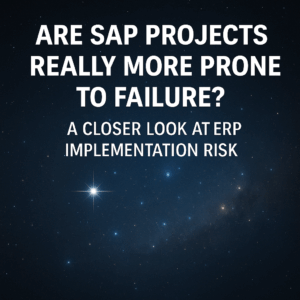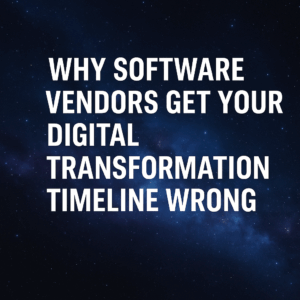It’s widely understood that software training and user adoption are critical factors to any digital transformation, however, most organizations don’t do these functions very well. Why is that and what is it you can do to ensure that you handle software training and user adoption successfully? That’s what we want to talk about in this article today.
Adoption is one of the critical components of a change management strategy and plan. In fact, it’s one of the more commonly understood aspects of change management and one of the areas that organizations recognize and need to focus on. However, most organizations aren’t very good at implementing software training and ensuring user adoption. What we would like to do today is talk about software training and user adoption, as well as some of the best practices you can use to ensure that you handle this work stream properly within your digital transformation strategy.

Table of Contents
ToggleThinking Beyond Training
The first thing that’s necessary to be successful when it comes to user adoption, is to ensure that you’re thinking beyond just simple software training. It’s critical to think outside the box of what it is you need to do beyond training alone to ensure that your employees fully understand and embrace their new processes, their new roles and their new responsibilities, as well as the new technologies and just overall changes to their organizational roles and responsibilities.
It helps to back up for a second and understand how people learn. There’s nothing wrong with this kind of training and you do need to do that as part of your overall change strategy but if you wait until that point in the project, right before go live, then you’ve waited too long to ensure that you are successful with the overall user adoption. That’s the first step, to think outside the box of traditional classroom based training and think about the comprehensive plan we need to have in place to ensure that we enable user adoption throughout the entire transformation.
End To End Business Processes
More often than not organizations hire a software vendor and they hire a technical implementer to implement technology. Software vendors end up creating training materials that are intended to show people how to use technology, that’s an important component of training and user adoption but it’s not a complete view of training and user adoption. Instead of learning how to use technology, we need to teach people how to do their jobs in the new post technology environment. This entails an understanding of end-to-end business processes, everything that happens in a end-to-end process within your organization. That certainly includes technology but it also might include touch points with other technologies that you already have in place.
The new technology might be the focus of training in many cases but you also need to build in an understanding of what other systems end users are going to touch or what sort of manual processes or decisions need to be made within that overall context of the end-to-end business process. It’s vitally important to back up and look outside of the myopic view of technology training and focus more on end-to-end business process training as your focus for user adoption.
Change Impacts
In addition to training employees on what their end-to-end processes are and the technology or technologies they’re going to use within those end-to-end processes, it’s also important that employees understand how their jobs are going to change as a result. In other words, as we’re training people on how to do these new processes and use these new technologies, we have to do so in the context of comparing it to what they’re doing today.
If you think about the average employee, they already understand pretty well what they’re doing today, they understand all the nuances, they understand the terminology of the technology they’re using, they understand the good, the bad, the ugly of the technology they’re using. So we need to relate it back to what they’re doing today so they understand how they need to change going forward. That may sound simple enough but it’s an important nuance that often gets overlooked in training and user adoption strategies. Too often we focus exclusively on training people on what the new process is or what the new technology is but as an employee they need to understand how those new processes tie back to what they are doing today so that they can change their behavior, change processes, change roles and change use of technology.
When we’re thinking about user adoption strategies that are most effective, it’s important to ensure that we’re training people in the context of connecting the dots between the way they do business today and the way they do their jobs today, versus the way they’re going to need to do their jobs in the future.
Systems Use
Thus far, We have talked about end-to-end business processes and change impacts and how we need to think outside the box of training strategies. That’s all important information but we do also need to focus on technology. We don’t want to dismiss the fact that we do need people to understand how to use new technology, how that user interface works, how the transactions work and how they find different menu paths within the system. We don’t want to wait until end user training to train people how to use the new system. If we wait until end user training, shortly before go live, then we’ve waited too long. It’s impossible to impose that sort of change and train people on new processes in such a short period of time. Changes that are typically pretty significant for most people within organizations that go through digital transformations are significant enough that they need time for it to marinate and sink in. We have to think outside the box of what we do before we get to end user training to start to build that case and build that foundation for change behavior and the new behaviors that we want from employees.
This is where we think about other opportunities to start communicating change, starting to communicate process changes, as well as how to use the new technology within the future state environment. For example, one tactic that’s highly effective in starting to build and change people’s behavior is through user acceptance testing. User acceptance testing is a process that’s typically used to ensure that the software works and fits the business needs from a business perspective but it can also be highly effective in ensuring that people understand and start to learn how that new technology works. It’s a precursor to the end user training that happens shortly before go-live. It’s a great way to build a foundation and start to get people comfortable with the technology well before you get into the formalized training.
Another tactic that’s highly effective early in a project, all the way through and after go-live is to build digital adoption tools. Tools that people can learn at their own pace either in terms of a formalized learning structure and or through tutorials. That can be a highly effective way to ensure that you start to get people comfortable with the change not only before go-live and leading up to go-live but even after go-live to provide that as a support tool and mechanism going forward.
Some software vendors do have their own digital adoption tools but often the software vendors tools are focused on how to just use their software, so, the key here is to find a digital adoption tool that’s technology agnostic, that looks beyond just one technology, to help build training materials and collateral to help people understand their processes, their roles as well as potentially multiple technologies they might be using to perform their jobs.
For example, at Third Stage Consulting, we have a proprietary digital adoption tool that’s technology agnostic and can be used in any web-based or browser-based software platform. Whether it’s your new system or your old legacy systems or some sort of combination of both, this digital adoption tool can be used to provide tutorials and on-demand training and guides that people can use on their computers to figure out how to perform their business processes and transactions within your system. Whether you use this digital adoption tool or any other, it’s important to recognize that there are multiple ways to ensure that people learn technology. You want to be doing so in a way that brings that process or that activity forward as early in the project as possible.
Don’t Stop at “Pre Go-Live Training”
The final step in ensuring you have a successful user adoption strategy is to ensure that you don’t view end user training as a one-and-done sort of event. In other words, training should not be this culmination of activities that lead to pre-go live training, that then leads into go live. That’s an important milestone, it’s one of a sequence of events but it shouldn’t stop there, you should have ongoing refresher trainings, you should have ongoing support materials, ongoing online access and social media tools internally that can be used to help ensure that end users and employees have the resources they need to perform their jobs.
Likewise, they have access to resources that can help them do their jobs. It’s important to think about your user adoption and training strategy as an end-to-end process that begins as early as possible in your transformation journey and continues well beyond go live so that you have ongoing collateral materials to help employees do their jobs.
These are some of the strategies and tactics we’ve seen work best when it comes to software training and user adoption and software training and user adoption is one of many pieces of an effective change management strategy.

If you are looking to strategize an upcoming transformation or are looking at selecting an ERP system, we would love to give you some insights. Please contact me for more information eric.kimberling@thirdstage-consulting.com





